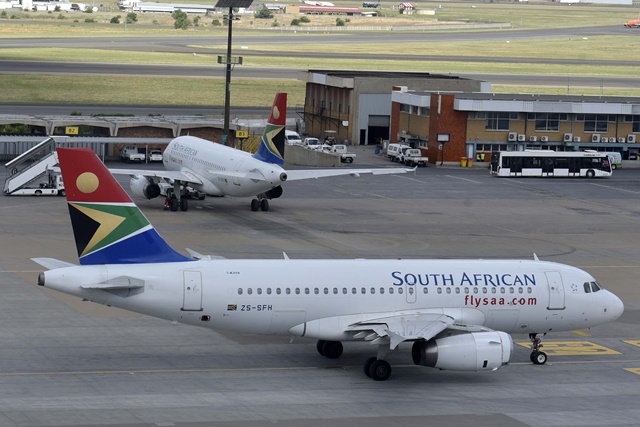Not only are the country's main airlines fighting for their lives, the vital aviation supporting industries like airports, air traffic management and weather services are also teetering on the brink.

SAA planes at OR Tambo International Airport, 14 November 2019. Picture: Neil McCartney
South Africans who have been dreaming of boarding a flight to an exotic holiday destination when the Covid-19 lockdown ends may just have to keep on dreaming, because the country’s entire aviation industry is on the ropes and it’s not inconceivable that it could “crash and burn”.
Apart from the devastation the pandemic has wrought on global aviation due to border lockdowns and other factors, the weakness of the local airlines also leaves regional airlines in a bother.
National airline SAA has only five airplanes left after returning 36 planes to their leasing companies and putting nine planes up for sale. These planes have still not been sold and are unlikely to sell, leaving the embattled state-owned airline with only one potential opportunity to recover some money from them: break them up and sell whatever can be used for scrap.
Apart from that, it is common cause that the airline is bankrupt in spite of receiving billions of rands in bailouts from government – and Finance Minister Tito Mboweni recently refused to extend an additional R10 billion for SAA’s rescue plan. These funds are needed for working capital, Moneyweb reported, paying off creditors and covering retrenchment packages.
Where the money will come from is not clear, although government has said in a letter to the rescue practitioners it would “mobilise” funding.
Mango, a subsidiary of SAA, is also in trouble and needs a bailout of R1 billion according to the business rescue practitioners. On top of that, the planes Mango use are getting old – they were already delivered in 2000 / 2001 – and will need replacement at some stage, says managing director of Plane Talking, Linden Birns.
Comair – the operator of Kulula and British Airways flights in South Africa – has also been grounded and two of its divisions are also in a business rescue process, which started on 5 May this year. However, it is facing possible liquidation after banks this week refused a request for R226 million in funding from the rescue practitioners.
The funding, which is known as post-commencement funding (PCF), is crucial as it would fund Comair’s operations until October while a business rescue plan was put in place, Daily Maverick reports. Without the funding, the business rescue practitioners “will be forced to stop proceedings, which might bring Comair closer to liquidation, which involves selling its assets to pay R4.6-billion owed to creditors”.
“In the absence of any PCF, and a capital raising process to underpin the financial and operational elements of a business rescue plan, we will have no other option but to conclude that there is no longer a reasonable prospect of rescuing the company,” the business practitioners told Daily Maverick.
But that is just one part of the story. If airlines don’t fly, nobody in the aviation supporting industries makes any money, as a percentage of every ticket sold goes to vital services such as airports, air traffic management, weather services, security and various private firms, says Birns.
“These services absolutely have to function [for airplanes to be able to take off and land, and airports to function],” Birns says. “But they are all in a severe cash liquidity crisis because they have received no money through the fees they usually get from airlines’ ticket sales. All of them have had to put their plans on hold.”
This presents a challenge to the entire industry to keep afloat, not only locally but also also globally, Birns says.
“Comair, SAA, Airlink, FlySafair, cross-border flights… they are all mutually dependent due to the symbiotic relationship they used to enjoy.
“It all depends on passenger volumes – the more passengers there are, the more revenue gets generated, services can get paid and airlines can make a profit.”
However, at the moment there are almost no passenger volumes due to Covid-19 restrictions, although SAA has resumed flights for business passengers.
“Just look at flights between Cape Town and Johannesburg, which used to be the busiest route in South Africa before the coronavirus restrictions. There used to be about 54 flights between the two cities on average per day. Now there are only five or six flights per day for business passengers. This is not sustainable,” Birns says.
For more news your way, download The Citizen’s app for iOS and Android.





